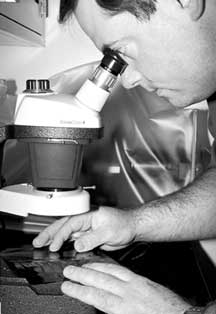                                                |
|
For
bioterrorism technology research—
YSI
receives $920,000 state grant
 |
|
YSI
Scientist Mike Dziewatkoski looking at a water monitering instrument.
|
The threat of bioterrorism
has started to drive market needs that now involve a Yellow Springs business.
In February, the State of Ohio awarded to YSI Incorporated a $920,000
Technology Action Fund grant that would enable the company to develop
a system for detecting pathogens in drinking water. The project, if successful,
has the potential to create hundreds of high-tech jobs in the area.
One month following the 9/11 disaster when the threat to air and waterways
was heightened, the U.S. Environmental Protection Agency began working
cooperatively with industries with experience in water detection, including
YSI, which had been developing water monitoring technology for decades,
according to Vice President of YSI Environmental Gayle Rominger.
While the company had previously been developing early warning systems
for water contamination, it had not considered response to threats of
mass scale, said Rominger.
“We had never thought about it at all, and I was sort of taken aback
when we started getting calls in October from the EPA,” she said.
“After some internal discussion we decided this was something we
needed to pay attention to.”
YSI quickly partnered with the University of Cincinnati, which was researching
a method of detection known as immuno-assay, a process that uses synthetic
antibodies that attach to waterborn pathogens exactly like human antibodies
do.
Over the next year YSI spent close to a half a million dollars designing
a vessel that could apply the synthetic antibodies to detect pathogens
in water, Rominger said. The company invented a microfluidic plastic pump
that can take a few drops of water and, using fluorescence, test instantly
for an unlimited number of bacterial and viral pathogens such as anthrax,
botulism or the ricin toxin.
“A lot of the genius is taking the technology and putting it into
a package that can be used in the field,” Rominger said.
YSI scientist and project manager Mike Dziewatkoski left a previous job
in Boston to get involved with what he called “new and exciting research
that is pretty much at the cutting edge.” For a company in a rural
setting to have such a sizable grant is unusual, he said.
“Visitors are amazed at the open spaces, and then to suddenly come
upon a company with this sophisticated technology,” he paused. “It’s
been a good environment for us to do our work in.”
The new technology has the potential to create a good number of high paying
jobs in marketing, product development and technological support, as well
as some manufacturing jobs.
“If this was accepted globally as a standard product for this work,
hundreds of people could potentially be hired,” Rominger said.
That amount of growth would probably require some company expansion. While
the expansion will probably take place in Yellow Springs, it could also
happen in Dayton or Cincinnati, said Rominger, who said whether or not
the company stays in the village depends on how the village responds to
the company’s needs.
The number of employment opportunities satisfies the terms of the TAF
grant, which was developed in 2002 as part of Governor Bob Taft’s
Third Frontier effort to make Ohio a high-tech leader. Rominger said YSI
could possibly start hiring in 2005.
There are a fair number of other companies looking at developing this
technology, according to Rominger. But YSI has a lot of practical experience
working with the water plants and creating something the plants can use.
“Terrorism has only been a market opportunity in the U.S. in the
past 18 months,” she said. “The big thing YSI has going for
it is 30 years’ success in the market, and YSI is extremely blessed
with a very strong brand name.”
The biotechnology and medical diagnostic fields are rife with market opportunity
for developing new products. According to Rominger, if you can measure
things in water then you can measure things in other media, and the technology
could also transfer to monitoring air quality.
“It could be a whole platform technology,” Rominger said. “There’s
always an opportunity for something less complicated. There’s always
room for new technology.”
—Lauren
Heaton
|



